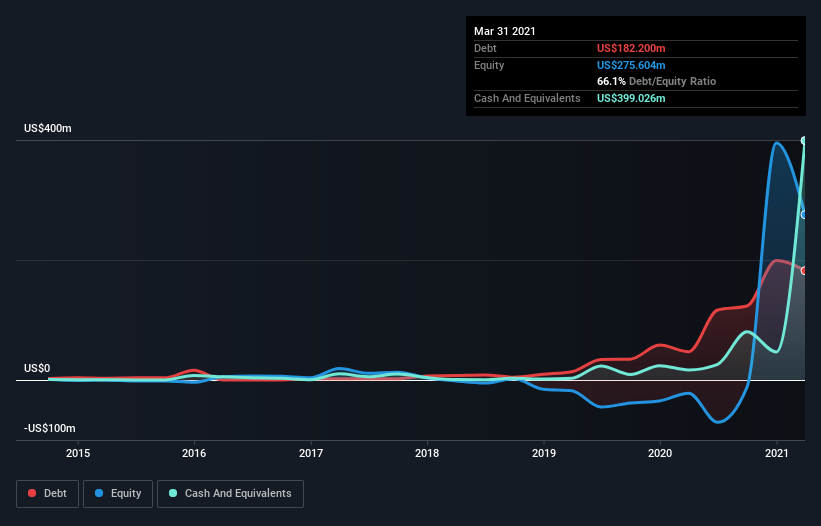Is Workhorse Group (NASDAQ:WKHS) Using Too Much Debt?
The external fund manager backed by Berkshire Hathaway's Charlie Munger, Li Lu, makes no bones about it when he says 'The biggest investment risk is not the volatility of prices, but whether you will suffer a permanent loss of capital.' So it seems the smart money knows that debt - which is usually involved in bankruptcies - is a very important factor, when you assess how risky a company is. We note that Workhorse Group Inc. (NASDAQ:WKHS) does have debt on its balance sheet. But the more important question is: how much risk is that debt creating?
What Risk Does Debt Bring?
Generally speaking, debt only becomes a real problem when a company can't easily pay it off, either by raising capital or with its own cash flow. Part and parcel of capitalism is the process of 'creative destruction' where failed businesses are mercilessly liquidated by their bankers. However, a more frequent (but still costly) occurrence is where a company must issue shares at bargain-basement prices, permanently diluting shareholders, just to shore up its balance sheet. Of course, the upside of debt is that it often represents cheap capital, especially when it replaces dilution in a company with the ability to reinvest at high rates of return. When we examine debt levels, we first consider both cash and debt levels, together.
Check out our latest analysis for Workhorse Group
How Much Debt Does Workhorse Group Carry?
The image below, which you can click on for greater detail, shows that at March 2021 Workhorse Group had debt of US$182.2m, up from US$47.1m in one year. But it also has US$399.0m in cash to offset that, meaning it has US$216.8m net cash.
How Healthy Is Workhorse Group's Balance Sheet?
According to the last reported balance sheet, Workhorse Group had liabilities of US$17.6m due within 12 months, and liabilities of US$186.6m due beyond 12 months. Offsetting these obligations, it had cash of US$399.0m as well as receivables valued at US$1.14m due within 12 months. So it can boast US$196.0m more liquid assets than total liabilities.
This surplus suggests that Workhorse Group has a conservative balance sheet, and could probably eliminate its debt without much difficulty. Succinctly put, Workhorse Group boasts net cash, so it's fair to say it does not have a heavy debt load! When analysing debt levels, the balance sheet is the obvious place to start. But it is future earnings, more than anything, that will determine Workhorse Group's ability to maintain a healthy balance sheet going forward. So if you're focused on the future you can check out this free report showing analyst profit forecasts.
Over 12 months, Workhorse Group reported revenue of US$1.8m, which is a gain of 1,792%, although it did not report any earnings before interest and tax. That's virtually the hole-in-one of revenue growth!
So How Risky Is Workhorse Group?
By their very nature companies that are losing money are more risky than those with a long history of profitability. And the fact is that over the last twelve months Workhorse Group lost money at the earnings before interest and tax (EBIT) line. Indeed, in that time it burnt through US$104m of cash and made a loss of US$55m. Given it only has net cash of US$216.8m, the company may need to raise more capital if it doesn't reach break-even soon. The good news for shareholders is that Workhorse Group has dazzling revenue growth, so there's a very good chance it can boost its free cash flow in the years to come. High growth pre-profit companies may well be risky, but they can also offer great rewards. There's no doubt that we learn most about debt from the balance sheet. However, not all investment risk resides within the balance sheet - far from it. These risks can be hard to spot. Every company has them, and we've spotted 3 warning signs for Workhorse Group (of which 1 can't be ignored!) you should know about.
Of course, if you're the type of investor who prefers buying stocks without the burden of debt, then don't hesitate to discover our exclusive list of net cash growth stocks, today.
This article by Simply Wall St is general in nature. It does not constitute a recommendation to buy or sell any stock, and does not take account of your objectives, or your financial situation. We aim to bring you long-term focused analysis driven by fundamental data. Note that our analysis may not factor in the latest price-sensitive company announcements or qualitative material. Simply Wall St has no position in any stocks mentioned.
Have feedback on this article? Concerned about the content? Get in touch with us directly. Alternatively, email editorial-team (at) simplywallst.com.

 Yahoo Finance
Yahoo Finance 
